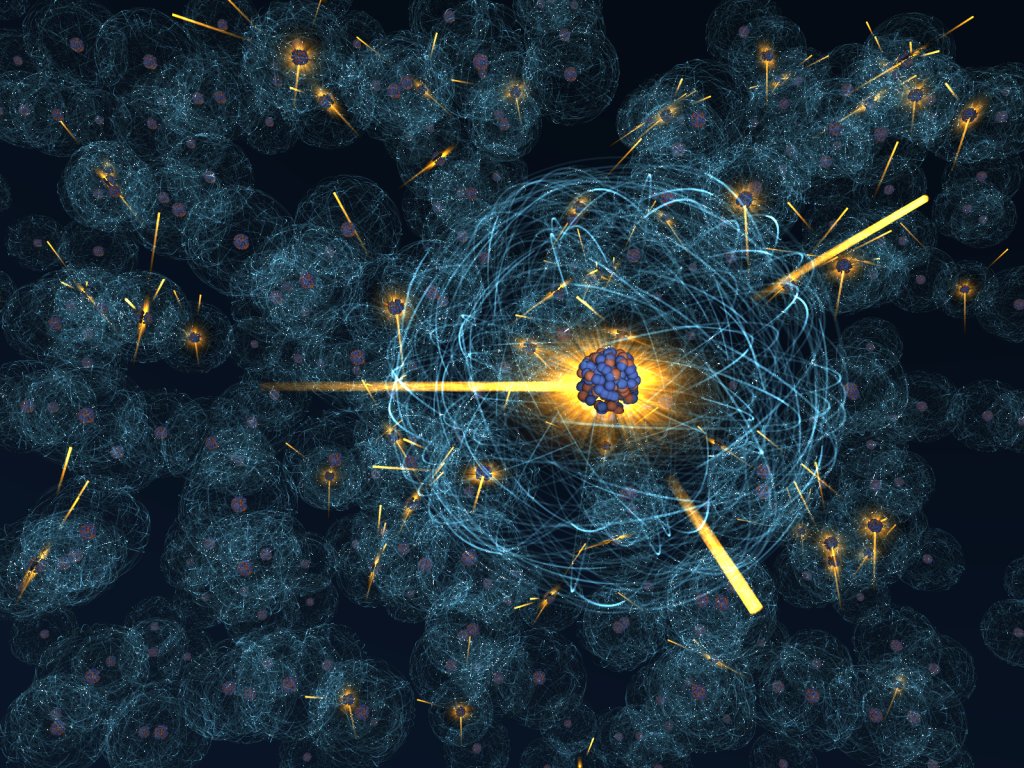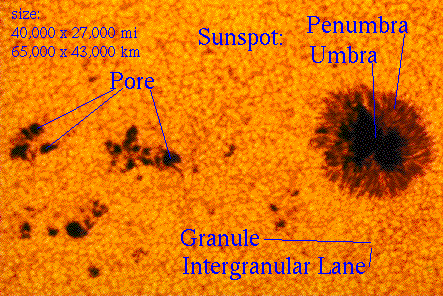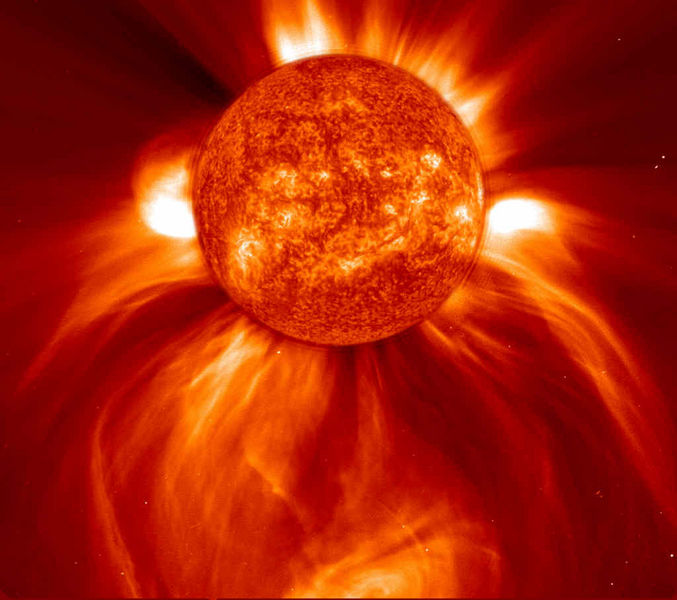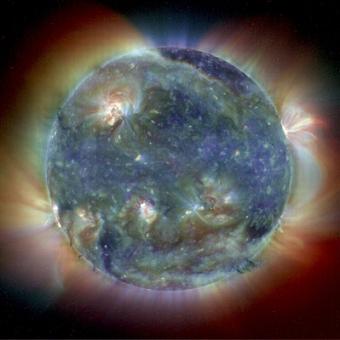
The four large moons of Jupiter are very large, ranging in size from Europa, only a bit smaller than the earth’s moon, to Ganymede, which is larger than the planet Mercury. Certainly, they are large enough to have been discovered even through the crude telescope of Galileo Galilei, after whom they have been given their group name. In his notebooks, Galileo called the moons simply I, II, III, and IV. Fortunately, they were eventually given more poetic names, Io, Europa, Ganymede, and Callisto, drawn from Roman mythology. These four are, appropriately, the attendants serving the god Jupiter.
Io is closest to Jupiter, orbiting at an average distance of 261,640 miles (421,240 km);
Europa comes next (416,020 miles or 669,792 km); then Ganymede (663,400 miles or 1,068,074 km); and finally Callisto (1,165,600 miles or 1,876,616 km). Intriguingly, data from Galileo suggests that the core of Io is metallic, and its outer layers rocky—much like the planets closest to the sun. Europa has a rocky core, with a covering of ice and water. The two outer large moons, Ganymede and Callisto, also have more icy surfaces surrounding rocky cores.
This pattern of decreasing density with distance from the central body mimics that of the solar system at large, in which the densest planets, those with metallic cores, orbit nearest the sun, while those composed of less dense materials orbit farthest away. This similarity is no mere coincidence and can be used to discover more about how the Jupiter “system” formed and evolved.
Let’s look briefly at each of Jupiter’s large moons.
Because of our own moon, we are accustomed to thinking of moons generally as geologically dead places. Nothing could be further from the truth in the case of Io, which has the distinction of being the most geologically active object in the solar system. Io’s spectacularly active volcanoes continually spew lava, which keeps the surface of Io relatively smooth—any craters are quickly filled in—but also angry-looking, vivid orange and yellow, sulfurous. In truth, Io is much too small to generate the kind of heat energy that produces vulcanism (volcanic activity); however, orbiting as close as it does to Jupiter, it is subjected to the giant planet’s tremendous gravitational field, which produces tidal forces.These forces stretch the planet from its spherical shape and create the geologically unsettled conditions on Io. Think about what happens when you rapidly squeeze a small rubber ball. The action soon makes the ball quite warm. The forces exerted on Io by Jupiter are analogous to this, but on a titanic scale. Don’t invest in an Io globe for your desk. Its surface features change even faster than political boundaries on the earth! In contrast to Io, Europa is a cold world—but probably not an entirely frozen world, and perhaps, therefore, not a dead world. Images from Galileo suggest that Europa is covered by a crust of water ice, which is networked with cracks and ridges. It is possible that beneath this frozen crust is an ocean of liquid water (not frozen water or water vapor). Liquid water is certainly a requisite of life on Earth, though the presence of water does not dictate the existence of life. Still, the prospects are most exciting. Europa may be a literal lifeboat in the outer solar system, although before we get our hopes up, we need to realize just how cold Europa is at 130 K and how thin its atmosphere is—at a pressure approximately one billionth that on Earth. Ganymede is the largest moon in the solar system (bigger than the planet Mercury). Its surface shows evidence of subsurface ice that was liquefied by the impact of asteroids and then refrozen. Callisto is smaller but similar in composition. Both are ancient worlds of water ice, impacted by craters. There is little evidence of the current presence of liquid water on these moons.




 Most frequently at the peak of the sunspot cycle, violent eruptions of gas are ejected from the sun’s surface. The prominences and flares may rise to some 60,000 miles (100,000 km) and may be visible for weeks. Solar flares are more sudden and violent events than prominences. While they are thought to also be the result of magnetic kinks, they do not show the arcing or looping pattern characteristic of prominences. Flares are explosions of incredible power, bringing local temperatures to 100,000,000 K. Whereas prominences release their energy over days or weeks, flares explode in a flash of energy release that lasts a matter of minutes or, perhaps, hours.
Most frequently at the peak of the sunspot cycle, violent eruptions of gas are ejected from the sun’s surface. The prominences and flares may rise to some 60,000 miles (100,000 km) and may be visible for weeks. Solar flares are more sudden and violent events than prominences. While they are thought to also be the result of magnetic kinks, they do not show the arcing or looping pattern characteristic of prominences. Flares are explosions of incredible power, bringing local temperatures to 100,000,000 K. Whereas prominences release their energy over days or weeks, flares explode in a flash of energy release that lasts a matter of minutes or, perhaps, hours.












 An evening spent looking up under dark skies will convince you that stars can be breathtaking in their loveliness. We can appreciate why, for thousands of years, human beings thought that the stars were embedded in a perfect sphere, spinning and changeless. Yet, because of their great distance, theirs is a remote beauty. Many amateur astronomers are disappointed to discover that stars (other than the sun) look pretty much the same through even the best telescope. Our common sense sees little similarity between the distant, featureless points of light against a sable sky and the great yellow disk of daytime, whose brilliance overwhelms our vision and warms our world. Yet, of course, our sun is a star—and, as stars go, not a particularly remarkable one. We now turn our attention to the very center of our solar system, the parent of the terrestrial and jovian planets and their rings and moons. We have spent the last three chapters discussing the planets and their moons. But taken together, these objects represent only 0.1 percent of the mass of the solar system. The other 99.9 percent of the mass is found in the sun. Peoples of many times and cultures have worshipped the sun as the source of all life, and in some sense, they were right. The sun is our furnace and our light bulb: the ultimate source of most energy and light here on the earth. And because it contains almost all of the mass, it is the gravitational anchor of the solar system. Indeed, its very matter is ours. The early sun was the hot center of a swirling disk of gas and dust from which the solar system formed some 4.6 billion years ago. If the sun were a cake, the earth and the rest of the planets would be some flour left on the counter. But the sun is only one star in a galaxy containing hundreds of billions of stars. Astronomers feel fortunate that the sun is so nondescript a citizen of the galaxy. It is, of course, the star closest to us and its very averageness lets us generalize about the many stars that lie far beyond our reach. In this chapter we examine our own star, and begin to explore how the sun (and stars in general) generate the enormous energies that they do.
An evening spent looking up under dark skies will convince you that stars can be breathtaking in their loveliness. We can appreciate why, for thousands of years, human beings thought that the stars were embedded in a perfect sphere, spinning and changeless. Yet, because of their great distance, theirs is a remote beauty. Many amateur astronomers are disappointed to discover that stars (other than the sun) look pretty much the same through even the best telescope. Our common sense sees little similarity between the distant, featureless points of light against a sable sky and the great yellow disk of daytime, whose brilliance overwhelms our vision and warms our world. Yet, of course, our sun is a star—and, as stars go, not a particularly remarkable one. We now turn our attention to the very center of our solar system, the parent of the terrestrial and jovian planets and their rings and moons. We have spent the last three chapters discussing the planets and their moons. But taken together, these objects represent only 0.1 percent of the mass of the solar system. The other 99.9 percent of the mass is found in the sun. Peoples of many times and cultures have worshipped the sun as the source of all life, and in some sense, they were right. The sun is our furnace and our light bulb: the ultimate source of most energy and light here on the earth. And because it contains almost all of the mass, it is the gravitational anchor of the solar system. Indeed, its very matter is ours. The early sun was the hot center of a swirling disk of gas and dust from which the solar system formed some 4.6 billion years ago. If the sun were a cake, the earth and the rest of the planets would be some flour left on the counter. But the sun is only one star in a galaxy containing hundreds of billions of stars. Astronomers feel fortunate that the sun is so nondescript a citizen of the galaxy. It is, of course, the star closest to us and its very averageness lets us generalize about the many stars that lie far beyond our reach. In this chapter we examine our own star, and begin to explore how the sun (and stars in general) generate the enormous energies that they do.

 If, having been discovered in 1930, Pluto was a late addition to our known solar system, its moon, Charon, is almost brand new, having been found in 1978. Named, fittingly, for the mythological ferryman who rowed the dead across the River Styx to the underworld ruled by Pluto, Charon is a little more than half the size of its parent: 806 miles (1,300 km) in diameter versus Pluto’s 1,426 miles (2,300 km). Orbiting 12,214 miles (19,700 km) from Pluto, it takes 6.4 Earth days to make one circuit. Pluto and Charon are tidally locked—forever facing one another; the orbital period and rotation period for both are synchronized at 6.4 days. Like Venus and Uranus, Pluto’s rotation is retrograde spinning on its axis in the opposite direction of most of the planets.
If, having been discovered in 1930, Pluto was a late addition to our known solar system, its moon, Charon, is almost brand new, having been found in 1978. Named, fittingly, for the mythological ferryman who rowed the dead across the River Styx to the underworld ruled by Pluto, Charon is a little more than half the size of its parent: 806 miles (1,300 km) in diameter versus Pluto’s 1,426 miles (2,300 km). Orbiting 12,214 miles (19,700 km) from Pluto, it takes 6.4 Earth days to make one circuit. Pluto and Charon are tidally locked—forever facing one another; the orbital period and rotation period for both are synchronized at 6.4 days. Like Venus and Uranus, Pluto’s rotation is retrograde spinning on its axis in the opposite direction of most of the planets.












